Ruy Lopez - Original Chess Champion

Chess Masters - Ruy Lopez de Segura
Lopez is also widely considered as the Father of Chess Theory. His famed literary chess work, Libro de la Invencion Liberal y Arte del Juego del Axedrez (Book of Liberal Invention and Art in the Game of Chess) is said to be the beginning of a long road to document chess strategy.
He gave a detailed description of the Spanish Opening in the book. It's one of White's fundamental Kingside opening systems and came to be named after the Spanish master. You may have heard of it by it's alternative name, the Ruy Lopez Opening.
Young Ruy
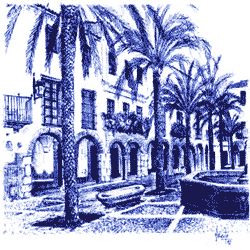
Plaza Grande
He was said to be influenced by the work of the Portuguese master Pedro Damiano who had written a book in 1512. He later claimed that Damiano's book gave him the idea to write his own.
Ruy and his brother Alonso wanted to be priests as children. The family enabled them to study in the clergy. His fame as a chess player grew quickly. He was beating many great players across Spain as a youth. Then he overcame the Spanish champion, Alfonso Ceron, of Granada. He was invited to the Royal Court in Madrid to play for King Phillip II.
The Court of King Phillip II
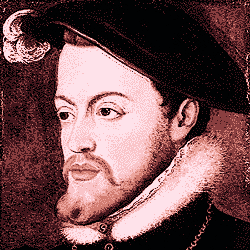
King Phillip II
Lopez would play all of the best players, not only in Spain but throughout Europe. He proved himself to have no equal and the King rewarded him with gold and property, declaring him a noble.
Italy was the only country that could compare with Spain in chess during this era. It's not surprising as the two countries had deep political and cultural links.
Some fine players were emerging there, chief among them Giovanni Leonardo da Cutri and Paulo Boi. Lopez would have to face them sooner or later.
Italian Adventures
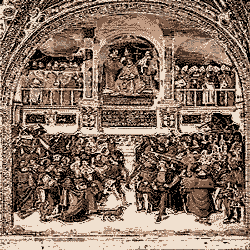
Lopez attended the Rome Coronation
Leonardo and Boi ruled the chess scene in Italy. They were eager to topple the Spanish master to make Italy the standard bearer of European chess. But Ruy Lopez had no plans to give up his crown as the #1 chess player.
Lopez proved too strong for the Italian masters and beat them both. Not many games from this period were recorded but one game from the 1560 showdowns has survived. Ruy Lopez - Giovanni Leonardo 1-0.
Madrid Tournament

Leonardo defeats Lopez
He beat highly esteemed masters such as Esquivel, Alfonso Ceron and Pedrosa. No one could argue with the idea that Lopez was the best in the world. He returned to Rome in 1572 to honor the new Pope, Gregory XIII. He once again beat Leonardo and Boi during his stay there.
King Phillip decided to organize the first big international chess tournament in Madrid. Spain's best players, Lopez and Ceron, would be joined by Italy's best, Leonardo, Boi and Polerio to compete for glory.
Leonardo and Boi both beat Lopez. Leonardo won the tournament outright to become the new champion. The era of Lopez supremacy was over.
Blessing the Prisoner

Ruy Lopez the Chaplain
The door opened and the executioner came in. 'How well', asked the monarch, 'is all set to proceed?' 'Lord, the inmate refuses.' 'How is that?' 'Because if you want to cut off a noble's head he asks to be blessed by a Bishop.'
'Granted, let it be as he wishes, but everything must be done by three o'clock.' The King turned to Ruy Lopez and said 'Arise, Bishop of Zamora, and go to assist the inmate.'
Ruy Lopez, with all the pain of his heart, rose and went to jail, compelled to issue last rites to none other than his close friend, the Duke of Medina Sidonia. The Duke was a former favorite of Philip II, now accused of conspiracy against the King.
The Duke of Medina Sidonia

Duke of Medina Sidonia
All wanted to see the current World Champion play one of his rivals. The Duke was also considered one of the best players of the time. The valiant Duke would spend his last hours of life locked in a chess struggle with the great Ruy Lopez. As the fatal hour of the execution drew near the game was at a critical point. The Duke was absorbed in the magnetic attraction of the war on the chess board.
He had glimpsed a winning combination. The chief guard and the executioner, meanwhile, tried to stop the game to immediately take the road to the place of execution. But the Duke wanted to finish the game. As the executioner insisted and attempted to use force, the Duke took the executioner's axe with great courage and arrogantly said, 'When you try to come near you'll lose your head.'
The Duke Defeats the Bishop
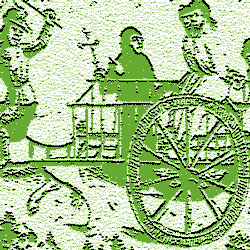
The Duke of Medina Sidonia on the way to his execution
Ruy Lopez smiled painfully and the spectators generously rejoiced the moment his noble adversary had achieved such a terrific result. He would die with the reputation of a victory over the World Champion.
After the game the Duke straightened up and went defiantly to his place of execution. He even found time to share jokes with his friend Ruy Lopez. He was ready to die but would not need to. His fortunes were about to turn for the better.
Conspiracy Uncovered

The conspirators against Phillip II were discovered
Unluckily for him, he took out the wrong document by accident. He took out the plan of the conspiracy with the list of conspirators and gave it to the King instead of the Royal Decree. He himself appeared first on the list.
The plan showed that the Duke of Medina Sidonia had been falsely accused. He had been supplanted in the favor of the monarch and unjustly accused of being a leader of that conspiracy. The King had the Count arrested and sent word ahead that the Duke had been pardoned.
The news reached those at the execution just in time and the Duke's life was spared. His life was saved by that game against Ruy Lopez that had delayed the execution by some hours.
Recorded Games of de Segura
Leonardo resigns when a Ruy Lopez combination ends in a Knight fork (12.Nf7+) winning the King's Rook
Four games from Ruy Lopez de Segura are all that remains. All of these were played against the Italian Giovanni Leonardo da Cutri. The first two feature Lopez playing with the White pieces and winning in 12 moves and then in 9 moves. The wins were gained playing with gambits. These games were played in 1560 and 1572 respectively.
The second two are taken from Leonardo's successful trip to Madrid. The games are scored as victories for the Italian. They show the only the opening 10 moves. Perhaps they are used by Lopez in his book during a discussion on the opening. Unfortunately we do not have the conclusion for either of these two games. Here are the four known games of Lopez.
Legacy of Ruy Lopez
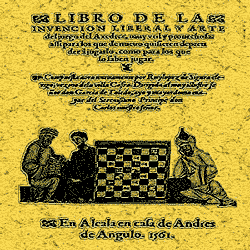
Libro de la Invencion
That's exactly what he did. He wrote Libro de la Invencion Liberal y Arte del Juego del Axedrez (Book of Liberal Invention and Art in the Game of Chess) in 1561. This work is widely considered to be the foundation of chess theory. The book has two parts. The first deals with the parallel between chess and war. It concentrates on the psychological elements of the battle of wills. The second part deals with the art of the game with a discussion on a number of openings. The Spanish Opening or the Ruy Lopez Opening is covered in great depth. The book also introduces the en passant rule and gives tips on blindfold chess.
Moving On
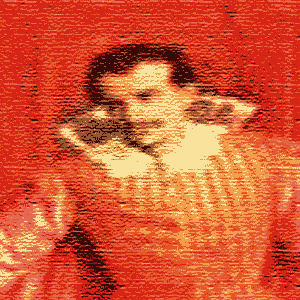
Giovanni Leonardo da Cutri
His great legacy is his literature contribution. His writings on the Spanish Opening, now called the Ruy Lopez Opening make his influence on chess still felt today.
He gave honorable service to Spanish chess, making it the European epicenter of chess for many years until the Italians finally seized the torch.
His mantle as Europe's leading player was finally taken by a man who Lopez had great respect for, both as a gentleman and a chess player. That man was the Italian master Giovanni Leonardo da Cutri.






